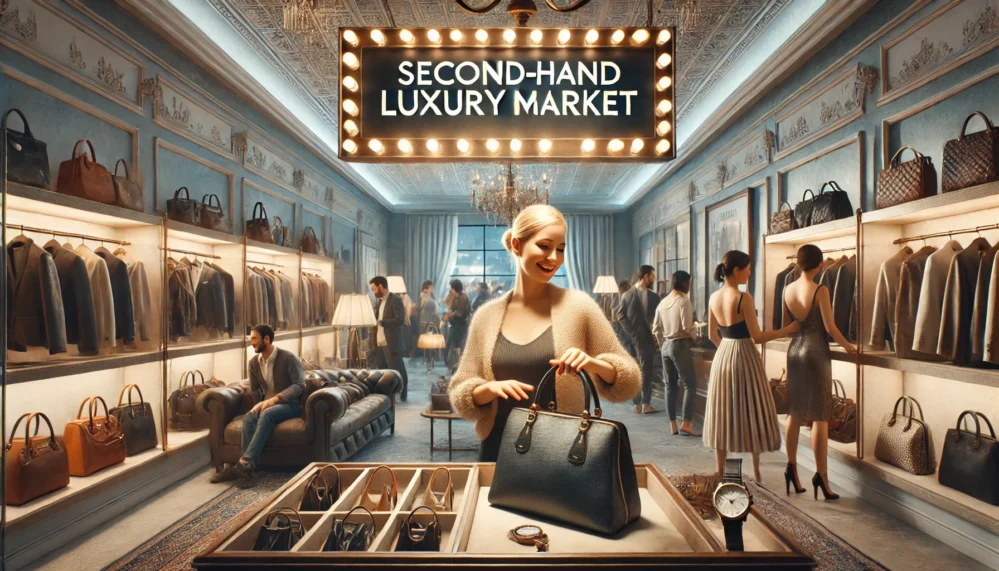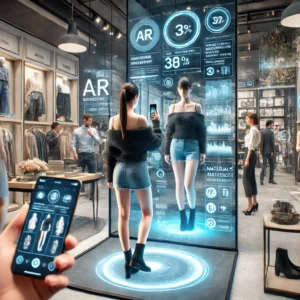
Picture this: a chic boutique where luxury isn’t just about flashy new items but about giving treasured pieces a second life. In today’s world, the ReCommerce boom is transforming the landscape of upscale resale, blending sustainability with affordability in ways that defy traditional fashion norms. From government policies and political debates to cutting-edge scientific research, celebrity endorsements, and generational shifts in consumer behavior, the second-hand luxury market is booming like never before.
A Fresh Spin on Luxury: The Resale Renaissance
Luxury used to mean exclusivity and brand-new allure. Now, a remarkable trend is shaking up this notion. The resale market for luxury goods is not only thriving—it’s redefining what it means to own high-end items. As sustainability and affordability drive this market, consumers are increasingly embracing the idea that pre-owned treasures can be just as desirable as their brand-new counterparts.
It’s almost like a treasure hunt: a vintage Chanel bag here, a limited-edition Rolex there. The thrill of finding a hidden gem at a fraction of the original price is unmatched. And, let’s be honest, who doesn’t love a good bargain that also helps the planet?

Sustainability and Affordability: Twin Engines of the ReCommerce Revolution
The dual appeal of sustainability and affordability is at the heart of the re-commerce boom. Shoppers today are more eco-conscious than ever, recognizing that reducing waste and extending the lifecycle of luxury goods can make a big impact on the environment. At the same time, the allure of saving money without compromising on quality has never been stronger.
According to recent insights from industry experts at Forbes, the second-hand luxury market is experiencing exponential growth as consumers turn away from fast fashion. In a time when climate change and resource scarcity are on everyone’s mind, buying pre-loved luxury is not just a trend—it’s a conscious lifestyle choice.
Government Insights and Political Buzz
Interestingly, the rise of re-commerce has not escaped the attention of government regulators and political commentators. Several governments around the globe are now taking note of the booming resale market, recognizing its potential to stimulate economic growth while promoting sustainable consumer practices.
For example, recent policy initiatives in Europe have begun offering incentives for businesses that support circular economies. In a somewhat divided political climate, some lawmakers argue that bolstering the second-hand market could reduce waste and lower carbon footprints. Conversely, others express concerns about regulatory oversights and taxation complexities in this emerging sector. The debate, though sometimes circuitous, underscores how re-commerce is reshaping economic policy discussions.
A recent article in the Financial Times highlighted how government-backed sustainability programs in countries like Germany and France are beginning to support upscale resale platforms, offering tax breaks and grants to companies that prioritize eco-friendly practices. This intertwining of politics and re-commerce not only legitimizes the market but also creates new opportunities for growth and innovation.
Science and Innovation: Research Labs in the Resale Revolution
In parallel with government initiatives, research laboratories and scientists are diving deep into the dynamics of the re-commerce boom. At renowned institutions like MIT and Stanford, experts are exploring the technological underpinnings of resale platforms. Their research focuses on enhancing authentication processes, using blockchain to verify the authenticity of luxury goods, and optimizing data analytics to predict resale values.
One notable project, detailed in a recent MIT Technology Review article, involves using artificial intelligence to analyze market trends and consumer behavior. This research not only ensures that luxury items are genuine but also provides valuable insights into pricing strategies and inventory management. In a way, these innovations are like the secret sauce behind the smooth operation of upscale resale platforms.
The interplay between technology and tradition in re-commerce is fascinating. Here, vintage charm meets modern data science—a quirky yet compelling blend that reflects the complexity of our current market dynamics.
Celebrity Endorsements: Glamour Meets Sustainability
It’s not all dry data and regulatory talk; the re-commerce boom has captured the imagination of celebrities as well. A-list icons and social media influencers are increasingly championing the second-hand luxury market. Recently, a famous Hollywood actress remarked, “Finding my signature designer piece pre-loved feels like an eco-friendly act of rebellion,” and that sentiment has resonated widely with her fans.
These celebrity endorsements add a layer of glamor and credibility to the market. When stars talk about the joys of owning a pre-owned Gucci bag or a vintage Hermès scarf, they’re not only making a style statement—they’re also highlighting the benefits of a more sustainable lifestyle. Their voices, amplified by millions of followers, help shift public perception. Now, owning second-hand luxury is seen not as a compromise, but as a smart, stylish choice.
Generational Views: Bridging the Old and the New
The re-commerce phenomenon is uniquely poised at the intersection of tradition and modernity, reflecting a fascinating generational divide. On one hand, many older consumers reminisce about the days when quality was built to last—when a luxury item was a lifetime investment. For these individuals, the resale market is a nostalgic nod to the past, a way to recapture the elegance of a bygone era.
On the other hand, younger consumers are driving the trend with a mix of excitement and pragmatism. Millennials and Gen Z, with their passion for sustainable living and digital savvy, are quick to embrace platforms that offer luxury at a more accessible price. They often see the resale market as a win-win: a chance to own coveted items while also supporting eco-friendly practices.
This diverse consumer base creates a dynamic, sometimes chaotic, yet always vibrant marketplace. Family gatherings now sometimes double as mini-lectures on sustainable fashion, with tech-savvy youth explaining the benefits of re-commerce to their more traditional elders. It’s a dialogue that bridges generations, blending personal history with futuristic trends.
Global Business Impact: ReCommerce in the Economic Spotlight
From Paris to Tokyo, the global impact of re-commerce is hard to ignore. Upscale resale platforms are no longer niche players; they’re major economic drivers that contribute significantly to global revenue streams. Recent market analyses by research firms like Statista indicate that the second-hand luxury market is set to reach unprecedented heights, with forecasts suggesting multi-billion-dollar revenues by the mid-2020s.
Big names in the luxury sector, including Burberry and Prada, are beginning to dabble in re-commerce, either by launching their own resale initiatives or partnering with established platforms. This shift reflects a broader change in consumer behavior—one that values longevity and authenticity over the ephemeral nature of fast fashion.
For global business leaders, the re-commerce boom represents a seismic shift. Not only does it open up new revenue streams, but it also challenges companies to innovate in terms of supply chain management and customer engagement. As the market matures, expect to see more cross-border collaborations and international summits dedicated to standardizing practices and boosting consumer trust.
A closer look at recent earnings reports reveals that companies heavily invested in re-commerce have reported impressive growth, with increased customer retention and higher average order values. For detailed financial insights, check out the latest report on Bloomberg.
The Social Fabric of ReCommerce: Uniting Communities
Beyond dollars and cents, the re-commerce boom weaves itself into the very fabric of our social lives. In bustling urban centers, upscale resale stores are becoming cultural hubs where fashion enthusiasts, collectors, and even curious passersby converge. These venues are not merely retail spaces; they are communal spaces where stories are exchanged, memories are revived, and identities are reshaped.
For older generations, the charm of owning a piece of history is invaluable. A well-worn designer bag might evoke memories of a bygone era, making each purchase not just a transaction, but a passage of legacy. Meanwhile, the youth revel in the idea of vintage chic, often using these items to craft unique, individualistic styles that defy mainstream fashion trends.
Social media amplifies these narratives. Platforms like Instagram and TikTok are awash with user-generated content celebrating pre-owned luxury, from unboxing videos to before-and-after transformations. These digital communities foster an environment where every item has a story, and every purchase is a statement of personal identity. They’re not just buying a product; they’re buying into a lifestyle, a commitment to sustainable luxury.
Challenges and Controversies: Navigating the Upside and Downside
Like any rapidly evolving industry, the re-commerce market isn’t without its challenges. Authenticity and fraud prevention remain significant concerns. Despite advances in technology, ensuring that every luxury item is genuine is a constant battle. Research labs are hard at work refining authentication processes, yet the occasional controversy over counterfeit goods still surfaces in the news.
Furthermore, as the market grows, so do regulatory challenges. Governments are grappling with how to tax second-hand sales fairly while encouraging sustainable practices. Some critics argue that the current regulatory framework is too fragmented, leaving consumers vulnerable and businesses unsure of their compliance obligations. These debates often spill over into the political arena, where policy proposals and counterproposals make for lively, if not occasionally disjointed, discussions.
Privacy and data security are also hot topics. With resale platforms increasingly relying on digital tools for everything from transaction tracking to customer relationship management, the risk of data breaches is ever-present. While many companies are investing in robust cybersecurity measures, occasional lapses serve as a sobering reminder of the vulnerabilities inherent in any digital ecosystem.
Looking Ahead: The Future of Second-Hand Luxury
As we peer into the future, the horizon for re-commerce appears both dazzling and uncertain. The next frontier could very well be the integration of augmented reality (AR) and virtual try-ons, offering consumers immersive shopping experiences that blur the lines between the physical and digital worlds. Imagine using AR to see how a vintage jacket might look on you before making a purchase, or even virtually exploring the storied history behind a luxury item.
Tech innovators and startups are already experimenting with these concepts, and while some ideas may seem a tad far-fetched today, the rapid pace of technological advancement suggests that nothing is off the table. What’s certain is that the re-commerce boom will continue to evolve, fueled by consumer demand, technological breakthroughs, and an ever-deepening commitment to sustainability.
The journey ahead is full of promise—but it’s also riddled with challenges that will require creative problem-solving and robust collaboration among industry stakeholders. In this dynamic ecosystem, every player, from governments and scientists to celebrities and everyday shoppers, has a role to play.
A Mosaic of Perspectives: Voices from All Walks of Life
The beauty of the second-hand luxury market is its ability to unite a diverse tapestry of voices. Consider the insights shared by a prominent fashion influencer who recently tweeted, “Pre-owned luxury isn’t just about saving money—it’s a rebellion against waste.” This sentiment echoes across various platforms and resonates with both the eco-conscious youth and the nostalgic older generation.
Older connoisseurs, who might reminisce about the era of timeless quality and craftsmanship, see re-commerce as a way to reconnect with the past. They argue that luxury, in its truest form, is meant to be cherished over time, not discarded after a fleeting moment of novelty.
On the flip side, young entrepreneurs view re-commerce as a disruptive force that challenges the status quo. With a blend of idealism and savvy business acumen, they are harnessing digital platforms to democratize luxury, making high-end fashion accessible to a broader audience. Their perspectives are refreshing, often punctuated with quirky memes and hashtags that capture the zeitgeist of modern consumerism.
FAQs
Q1: What is re-commerce in the context of luxury markets?
A: Re-commerce refers to the resale or second-hand market for luxury goods, where pre-owned high-end items are bought and sold. This trend is driven by sustainability, affordability, and a growing desire for unique, authentic products.
Q2: How do government policies impact the second-hand luxury market?
A: Governments are increasingly supporting circular economies through incentives, tax breaks, and sustainability programs, which can boost the growth of upscale resale platforms. However, regulatory challenges regarding taxation and consumer protection remain areas of active debate.
Q3: What role does technology play in ensuring the authenticity of resale items?
A: Advanced authentication methods, including blockchain and AI-powered analytics, are being employed to verify the genuineness of luxury items. Research institutions like MIT and Stanford are at the forefront of these innovations, working to minimize fraud and enhance customer trust.
Q4: Are there notable celebrity endorsements in the re-commerce space?
A: Yes, many celebrities have publicly endorsed the concept of pre-owned luxury. Their endorsements have helped shape public perception, positioning re-commerce not as a compromise but as a stylish and sustainable lifestyle choice.
Q5: How is the re-commerce boom affecting global business revenue?
A: Global revenue in the second-hand luxury market is on the rise, with projections of multi-billion-dollar growth in the coming years. This surge is attracting major luxury brands and investors alike, as detailed in recent reports from sources like Bloomberg and Statista.
A Call to Rediscover Luxury
The ReCommerce boom is more than a fleeting trend—it’s a cultural shift, a melding of history and innovation, a celebration of sustainability wrapped in the allure of luxury. Whether you’re an avid collector, a budget-conscious fashionista, or simply someone who values timeless quality, the second-hand luxury market invites you to rediscover what true luxury really means.
Curious to explore further? Dive into our other sustainable fashion insights or subscribe to our newsletter for a steady stream of industry updates and exclusive trends. In a world where every purchase tells a story, make sure your next chapter is both stylish and sustainable.




